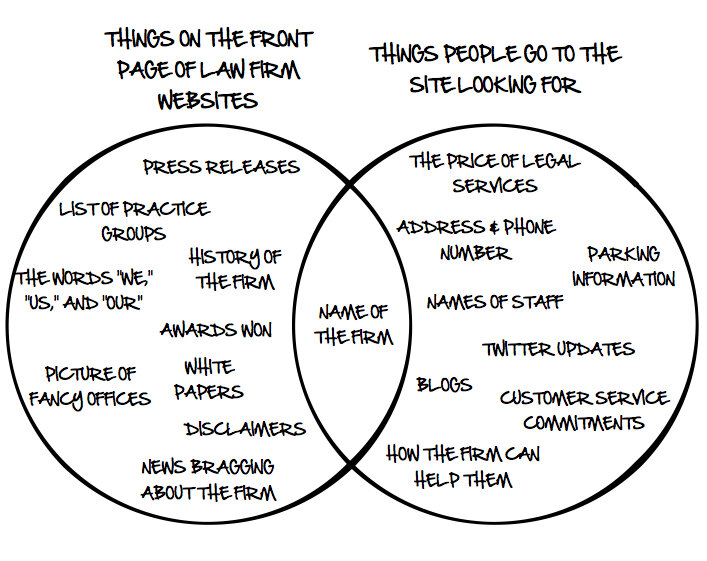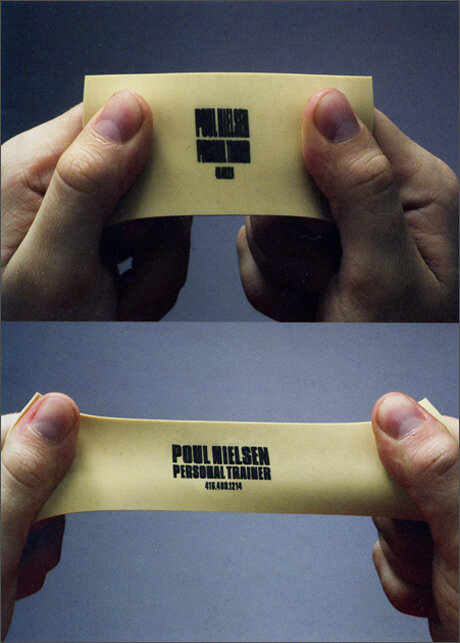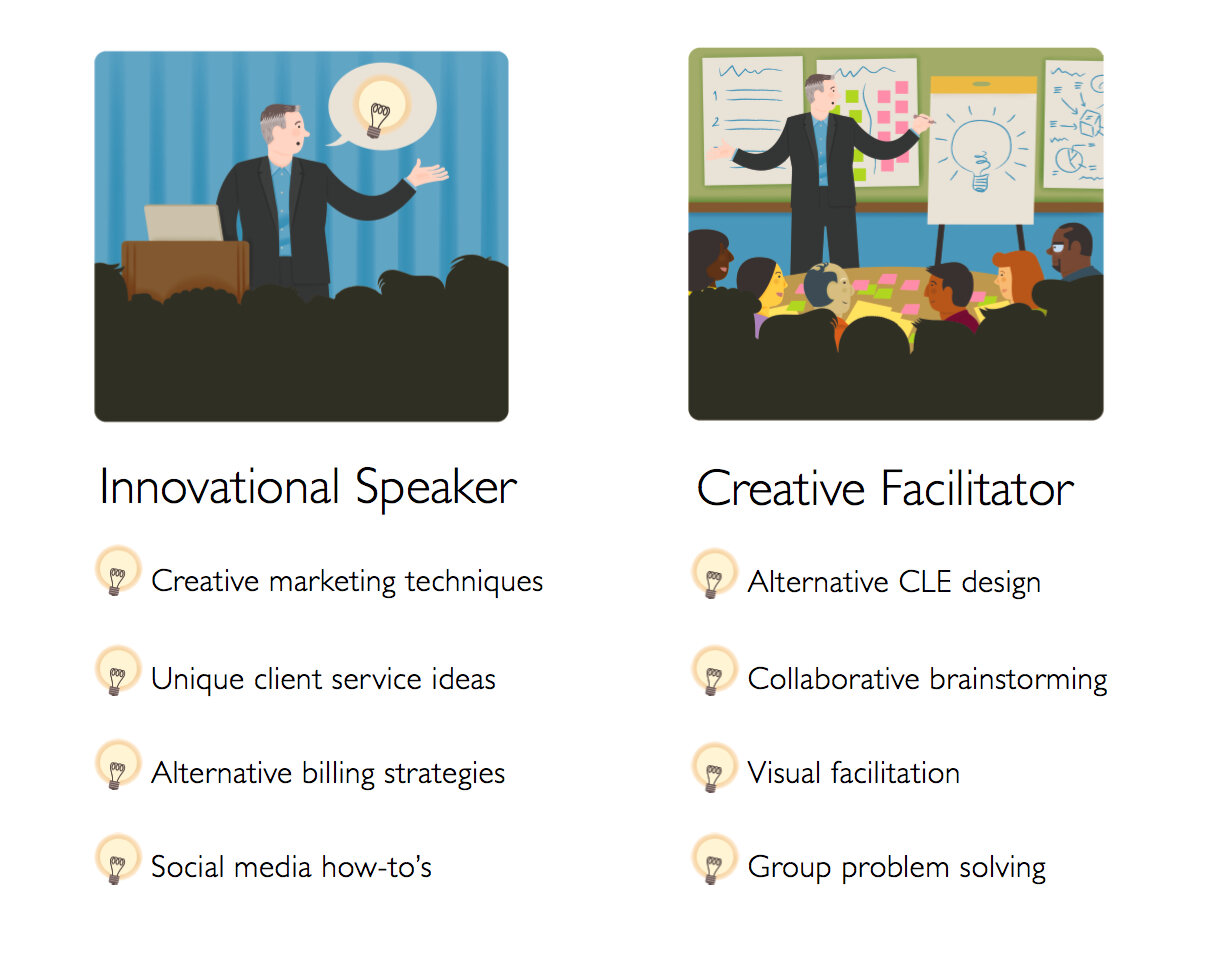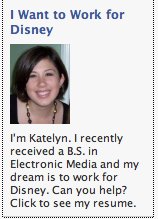Haiku Your Way to a Better Elevator Pitch
I'm a fan of Haiku, and have been doing an exercise based upon it for several years now at conferences and law firm retreats. Instead of the 5-7-5 syllable format, I ask my audiences to answer three questions, using just five words for the first question, seven for the second and five again for the third.
Though I'll use different questions depending upon the event, I recently spoke to the New York City Bar about in-person networking and gave these three questions as a way to quickly develop an "elevator speech" that responds to the "What do you do?" question we get all the time.
The three questions, which must be answered with the specified number of words, are:
- Who do I help? (Answer in Five Words)
- What do I do for them? (Answer in Seven Words)
- Why do they need me? (Answer in Five Words)
An example response to these questions from a business lawyer could be:
I help small business owners
incorporate their businesses and protect their assets
so they can sleep better.
Another example for a personal injury lawyer may be:
I help injured accident victims
understand their rights and recover medical expenses
from people who are responsible.
Give it a try. It isn't an easy exercise, but it will help you answer that all-to-common networking question with something other than, "I'm a lawyer."
Use the Right Words in Your Marketing
Found this great tip on Connection Cafe about how to use Google's Keyword Tool to understand what people are looking for:
Explore opportunities for new offers or ones adjacent to what you currently offer. Go to the Google Keyword Tool. Enter a single term associated with your organization’s services, products, or offers. You could also provide a URL to one of the pages that describe what you’re doing today and Google will use that to help with the research.
The tool will return a long list of similar terms that people are searching for. It will also tell you roughly how many people are searching for those terms and how competitive the market for placing advertisements on those pages will be. Sort by search volume or competition. What do these results tell you people are searching for versus what they’re finding?
Great Estate Planning Quote
Found this quote from professional organizer Sue DeRoos that would be a tremendous quote for a firm trying to market to estate planning clients:
Everyone gets organized at some point, they just might not be around for it.
Via Unclutterer.
Is your website for your clients or for your peers?
Inspired by this venn diagram found on Business Pundit, I thought I'd do one for Law Firm Websites:
What are your Relationship Rituals?
Keith Ferrazzi shares a few simple "Relationship Rituals" that should be on every professional's weekly checklist:
1. First thing every day after you turn on your computer, ping one friend and one acquaintance.
2. Every weekend, invite someone else into an activity that you normally do alone (walks, gym sessions, gardening, shopping trips).
3. Pick a day for a weekly check-in with a colleague/associate/friend, during which you share a success, a challenge, and make a commitment for the upcoming week.
4. Every Friday, send a broadcast – status update, blog post, Tweet, etc.
5. Host a monthly dinner or happy hour.
What are the things you do every week to maintain your client relationships?
Should you tell prospects why they shouldn't hire you?
Jessica Hische, a tremendous print designer and illustrator has a section on her website titled "Why you should not hire me to design your website." Some excerpts:
I might seem like a jack of all trades because I do print design, typedesign, lettering, and illustration, but really I’m a specialist. Ispecialize in drawing type and illustration. This is what I’m best atand is probably why you found my website in the first place. I find itstrange that I get so many requests for web design—I went to school forgraphic design, yes, but each subfield of graphic design has its ownset of problems, limitations, and guidelines.
Just as you wouldn’t expect any random person thatowns Adobe illustrator to be able to draw a decorative initial fromscratch, you can’t expect any print designer to be able to really andtruly design for web. Web design is not print design, it is so muchmore complex. With book design, a person that encounters your bookknows how to view it. They look at the cover, they open the cover, andpage by page they work their way to the end. With web design, it’s (forthe most part) not linear. You have to understand how people are goingto use the site (and how people use the web changes all the time).
Anyway, to conclude a fairly long rant: Hire people that are best atwhat they do. It’s not that I (or other print designers) CAN’T do webdesign, its that you should want to hire someone that will do itbest—someone that knows the ins and outs of the web and can then hirepeople like me to do what they do best: draw ornaments, logos,illustrations etc that will make the site sing.
I'm quite certain many lawyers and firms would benefit from a similar "disclaimer" telling potential clients why not to hire them. Communicating what you do -- and most importantly, what you don't (and won't) do -- goes a long way towards getting you the clients you want and dissuading the ones you don't from picking up the phone.
Stretch Your Thinking About Biz Cards
One of my favorite business cards of all time:

Check out the entire post at Creative Bits for lots of other cool, inspirational cards.
What Are Your Clients Afraid Of?
I saw this great over-the-counter medicine packaging (from Help Remedies), and was taken with the simple way each remedy's package focused how the consumer feels before using it.

I wonder if this simple message would work with law firm marketing? Instead of telling the world what you do, what if you focused your marketing message on how clients felt before hiring you? Start by answering this question: what are your prospective clients worrying about at the time they need you most?
Some Great Advice from Design Pros
I ran across this article titled I Wish I Would Have Known: Answers From 11 Top Freelancers, where several design professionals share their hardest lessons learned. Here are a few of my favorites:
From Steven Snell:
I wish I would have known that clients tend to not take a project veryseriously if they are paying low rates. When I started out I knew thatlearning and getting experience was more important than making money atthat stage, so I did some very cheap projects. I worked with severalpeople who wanted a website, but it seemed that since they wereinvesting very little into it financially, they just didn’t take itseriously and put in the effort on their end that is needed to have asuccessful web presence. Not only did that make it more difficult forme to do a good job, but it really did a dis-service to their businessbecause their websites weren’t as effective as they could have been.
From Sean Baker:
You’re closing up your meeting with a potential client. Everything wentsmoothly and you think you’re about to land the job. Said client asksfor your hourly rate, in which you give and explain. Unless you’reunderselling your talents greatly, their next question will almostalways be: “Great, and how long will it take you?” Suddenly you’re in acorner… and you’re panicked. You don’t want to scare them away, so youfeel implied to answer immediately, usually shorting yourself on timesimply to appease. Congratulations, you’ve just pigeonholed thisproject. From here you’ll either be doing some free work or you’ll runthe client off once they see a higher rate than you originally gave.
From Brian Yerkes:
You have to ensure that you don’t take it personally, ever. This is thebiggest thing that I personally struggle with. When a client emails totell me that they aren’t happy with a design, it puts me in a bad moodfor a few hours. It’s the number one thing that I try to deal withbetter every time it happens. Fortunately, 99% of the time, my clientsare happy with my work, but you can never win them all.
From Kostandinos:
Don’t be afraid to say “no” to a project. If I could only pass alongone small piece of advice to kids starting out, and even to thosewho’ve been at it for a while, that’s it. Sometimes it’s really notworth it… in more ways than one. Have a bad feeling about a client?Trust your gut and walk away. One more thing: Sometimes the most important and best projects arethe ones you do for yourself, including working on your portfolio andre-branding yourself. The devil is in the details… get out yourpitchforks.
This advice could have just as easily be given by (and to) lawyers. Remember, your clients, peers and friends often face the exact same challenges in their (non-legal) businesses. Engage them, learn from them, and don't make the same mistakes they have.
Revive Zombie Clients and Other Great Tips
There's some great, simple advice from the Freelance Folder in Seven Tips to Keep Your Clients Coming Back for More. The tips:
Offer packages for recurring work.
Give your best clients special treatment.
Revive “zombie clients.”
Mark important dates.
Foster a feeling of belonging in an exclusive club.
Create promos throughout the year.
Ask for referrals.
Go read the entire article. It is worth your five minutes.
Resolve to Support the Causes Your Clients Do
If you've got a big client, odds are they've got a pet project. Whether it is for a community organization, charity, civic group or volunteer event, supporting the causes your clients do can deepen your relationship with them while benefiting those in need.
That's why, in 2010 you need to Resolve to Take Care of Clients' Pet Projects. For every client, find out what kinds of charitable groups or causes they support (and why). Armed with this knowledge, here are a few things you can do:
- Get on the group's mailing list, so you'll always know how you can help.
- Donate money or goods to the cause's auction in your client's name.
- Instead of spending your time entertaining your clients, spend that time volunteering with them in support of their cause. You'll get the same one-on-one time with the client, but will be helping out those in need. As a extra bonus, you'll probably also get an introduction to several of your client's peers.
- Find out what is the most pressing legal issue facing the cause (or its members), and offer to give a seminar to help them understand it better.
- Donate a percentage of that client's fees to their cause as your holiday gift the client.
Your clients will not only appreciate your interest in their cause, but you might gain an interest in theirs. When that happens, everybody wins.
Resolve to Know Your Best Clients Better

Now that you've identified your worst clients, fired them, and stopped taking more like them, you can now focus your time and energy on building your practice doing the kinds of things you like to do for clients that you enjoy serving.
And the first step to take is to get to know your best clients better. Identify your seven favorite clients, past or present. Take them to lunch or dinner in person (or over the phone) and get to know them.
Make your time together about them. Tell them they're one of your favorite all-time clients and you wanted to catch up. Learn about their plans for the new year and the challenges they're facing. Talk about their family and hobbies. Find out about the charities they care about and the professional organizations they belong to.
But don't stop there. The more you know about your clients, the better you'll be able to serve them. A great list of things to could/should know about your clients is the "Mackay 66" (pdf download here).
And at the end of each conversation, don't forget to ask:
How do I find more clients like you?
Advertise What Matters (to Clients)
If you're wondering what to put on your website (or in that next yellow pages ad), take a cue from the Central Florida Regional Hospital in Sanford, Florida. Instead of trumpeting just how great their doctors are, they're using a nearby billboard to display a real-time statistic that lots of people care about: ER wait times.
From the Orlando Sentinel:
To find out how long the wait is in the emergency room at Central Florida Regional Hospital in Sanford, you can check its Web site, send a text, or, now, cruise past a billboard on Interstate 4.The hospital this week started posting its ER wait times on the billboard, on the eastbound side near State Road 46. It's part of a campaign to use technology to spread the word about decreasing the wait.
"Putting our wait times to see a physician in real time on a billboard is just one more step in educating the community about our service," said Wendy Brandon, the hospital's chief executive officer. The wait times to see a physician are updated every 30 minutes and reflect an average from the previous four hours.
What do your clients want to know about you? Do they see the answer in your advertising? They should.

Sell Me This Pencil
Here's a list of 100 Great Interview Questions, that includes most of the obvious ones, such as "What are your weaknesses?" and "What's your ideal company?" etc.
However, there was one "question" that stood out to me above all others:
Sell me this pencil.
Think about that for a moment. The question doesn't require an answer, it requires a performance. I wonder how it might impact hiring by law firms if their interviewers asked it just once in a while...

Introduce Your Staff to Your Clients
Here's a great idea from the London Underground (subway) via the U.K.'s Creative Review. The Underground hired photographer Maria Cox to visit each of the London Underground's 264 stations and take a picture of someone who worked there.
The photographs are combined with some information about each person, and then displayed at the station where he or she works. Here's the profile of John Osborne, a customer services assistant at the Shepherd's Bush Line station:

It makes me wonder how many businesses here in the states could benefit from a similar approach. I think many clients would be more apt to hire a firm that cared enough about their employees to feature them in this way. What do you think?

Some Tips for the Suddenly Solo
The fellas at Lawyerist caught up with me in Duluth after one of my presentations at Minnesota CLE's "Strategic Solutions for Solo and Small Firms" conference. Sam Glover asked me to share some tips for the "Suddenly Solo" lawyers out there. Here's the video:
Interview with Matt Homann from Lawyerist Media on Vimeo.

Business Card or Brochure? Both.
I'm headed to the ACLEA conference in Salt Lake City this week. I'm a new member of the Association of Continuing Legal Education professionals (I know, the acronym needs some help) and am looking forward to my first ACLEA event -- especially because I'm doing lots more speaking about innovation, creativity, marketing, alternative billing, etc. to lawyers, firms and at CLE's.
Since I'm working on a website redesign (live in August) that helps show visually what I do, I thought I'd use some of the images we've created for the web on new 3" x 5" business cards that double as a kind of brochure. (I'm using a 6" x 5" card folded in half).
Here's the inside of the folded card:
And here's the back and front:

And here are the LexThink cards I've been using. Let me know what you think! Here's the card in pdf format.

Using Facebook Ads to Find Legal Work
Attention Law Students: There's a great post over at One Day One Job abut Using Facebook Ads to Make Employers Hunt You Down that's definitely worth a read. It recaps an experiment where job seekers used targeted Facebook ads to reach people who worked for companies they admired. For Katelyn Hill (below), here's what happened:
Katelyn Hill recently graduated from Abilene Christian University with a degree in Electronic Media. She loves television and movies and hopes to work in the entertainment industry, so she targeted the Walt Disney Company with her Facebook advertising campaign. Her ad received 685 clicks, which garnered 21 e-mails and 4 Facebook messages. She was offered one job interview, but wasn’t quite qualified for the position, so she declined. She also had several e-mails from individuals who offered to forward her resume to their supervisors. Many others offered her general advice on finding a job with Disney or commented on how creative they thought her ad campaign was.
I think this is a brilliant idea. It isn't a reach to take this approach and target attorneys and staff at specific firms you'd like to work for.
It could (though your malpractice carrier may disagree) also work for lawyers targeting specific clients or types of work as well.
One Thousand Dollars an Hour is Dumb.
If you must compete on price, here's a McDonald's billboard that might give your marketing people some inspiration:
Found on Billboardom. Full Story Here.
A Social Media What-To-Do
Lots of folks are talking about using Social Media for business, including me. When I speak to lawyers, after the "What the heck is ..." questions come the "How much time will this take me?" ones. Last week, my friend Chris Brogan published his 19 Presence Management Chores You COULD Do Every Day post on his fantastic blog. In it, he shares 19 "chores" one could do every day (or at least every week) to keep one's online presence alive and kicking on Twitter, Facebook, LinkedIn and Blogs.
Here are his LinkedIn tips:
- Enter any recent business cards to invite them to LinkedIn (if you’re growing your network).
- Drop into Q&A and see if you can volunteer 2-3 answers.
- Provide 1 recommendation every few days for people you can honestly and fully recommend.
- Add any relevant slide decks to the Slideshare app there, or books to the Amazon bookshelf.
Nobody knows this growing world of "Presence Management" better than Chris, and I'd highly recommend you not only read his full post, but add some (or all) of his suggested "to-do's" to your list.


